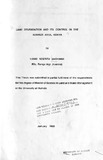Land degradation and its control in the Kibwezi area, Kenya
Abstract
Most of our semi-arid land is threatened with increased land deterioration due to
changes in land use especially in areas where soils have sealing properties which
hinder infiltration of rain- water. The study was carried out in Kibwezi Division,
Machakos District, a distance of 220 km. from Nairobi. It was designed to investigate
major causes of land deterioration following human settlement around 1963 and low
cost measures of reversing it.
The experiment was designed to investigate whether slashing bush and spreading
it on the denuded ground would improve infiltration and if so, whether the effect would
be due to interception of rainfall energy and reduced sealing, interception of runoff,
insect activity i.e. termites or other organisms living on the deadwood and breaking the
seal in the process or due to a combination of one or more factors. This was
investigated using twelve (12) runoff plots on a mean slope of 0.1% with ferral chromic
Luvisols and 20% brushwood cover. Different forms of treatments under natural rainfall
were applied. Supplementary studies on infiltration; after insect activity on the soil seal
when the soil seal is intact and after the soil seal is removed ,were conducted by
surface ponding next to runoff plots for comparison. A farm survey with a
questionnaire on causes and state of land deterioration, and measures used to
encourage revegetation, was carried out on settled areas. Studies were conducted to
determine the botanical composition of virgin land. Socia-economic data on some
plants, for example, Baobabs left in cropland, was collected from the local communities.
Treatment effects compared with the control plots, were significant (P (- 0.05) in
reducing soil loss and runoff. Rainfall and runoff interception using 20% brushwood
cover together with or without insect activity is significant in reducing soil loss and
runoff.
Bare denuded plots lost an average of 53% of the rainfall as runoff and 65.5t/ha.
of soil compared with 38% of rainfall as runoff and 19tjha. of soil from plots with
rainfall/ runoff interception together with insect activity. Rainfall interception only and
rainfall/runoff inter.~eption without insect activity lost a total of
32t/ha. and 25.7t/ha. respectively.
Efficiency values in reducing soil loss and runoff were generally high for all the
treatments. Raintall/runoff interception with insect activity treatment reduced soil loss
by 71% ,without insect activity 61%, and rainfall interception only by 51%
Soil sealing in semi-arid areas as a result of raindrop impact could be due to low
organic matter (~ 0.1%) and high sand content ( ~ 69%) and fine clay fractions which
could possibly block the soil pores after the soil aggregate disintegrates under raindrop
impact. Soil sealing may also be attributed to runoff. Clay fractions in the soil, act like
cement in sand and it contributes to the hardness of the soils during the dry season.
The effect of this is low infiltration, high runoff and water erosion when rains come.
Clay content at the soil surface causes decreased porosity and thus soil sealing.
Insect activities were found to assist in creating rough and fragmented surfaces on
the denuded sealed soils. This was found to enhance rainfall infiltration for a short
period on ponding water, implying that enhanced revegetation of denuded lands can
be achieved by creating conditions necessary for rainwater to pond.
Settlement in the area ,though relatively recent and mainly within the last 25 years,
has resulted in serious erosion in some places. This indicates that much greater
attention should be paid to soil and water conservation.
Most of the land deterioration from stable vegetated land with minimal soil erosion
has been due to vegetation removal exposing soil to accelerated erosion and increased
runoff in most cultivated farms. This has been made worse by poorly maintained and
. lor lack of soil and water conservation measures on cropland and lack of proper
grazingmanagement and jor restoring cover whenever it is diminished, by using
measures(example, temporary bunds, basins etc. ) intended to pr
Citation
Gachimbi, L.N(1990)Land degradation and its control in the Kibwezi area, KenyaSponsorhip
University of NairobiPublisher
Department of Range Management, University of Nairobi
Description
Msc Thesis

